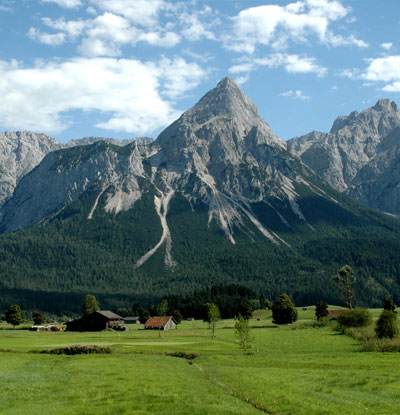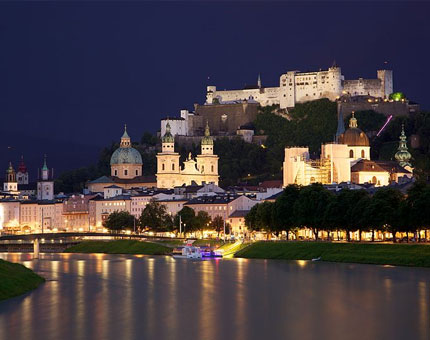Austria
Country statistics

Land area: 31,942 sq miles (82,730 sq km)
Total area: 32,382 sq miles (83,870 sq km)
Population (2010 est.): 8,214,160 (growth rate: 0.04%); birth rate 8.6/1000; infant mortality rate: 4.3/1000; life expectancy: 79.6; density per sq miles: 257
Capital City: Vienna
Monetary unit: Euro (formerly schilling)
Languages: German (official nationwide); Slovene, Croatian, Hungarian (each official in one region)
Ethnicity/race: Austrians 91.1%, former Yugoslavs 4% (includes Croatians, Slovenes, Serbs, Bosniaks), Turks 1.6%, German 0.9%, other or unspecified 2.4% (2001)
Religions: Roman Catholic 74%, Protestant 5%, Islam 4%, none 12% (2001)
Country introduction

Austria is a landlocked country in Central Europe, which is bordered by the Czech Republic and Germany to the north, Hungary and Slovakia to the east, Slovenia and Italy to the south, and Switzerland and Liechtenstein to the west.
While the Austrian Alps cover three quarters of the country, Austria amounts to more than its mountains. The provinces of Vorarlberg, Tyrol, Salzburg, Styria, Upper Austria and Carinthia, the eastern provinces of lower Austria, the Burgenland and the federal capital of Vienna are more similar to the geography of the neighboring Czech Republic and Hungary. This diverse mix of landscapes is packed into a relatively small area of size. Glaciers, meadows, alpine valleys, wooded foothills, gently rolling farmland, vineyards, river gorges, plains and even semi-arid steppes can be found in Austria.
One quarter of Austria's population lives in Greater Vienna, a European metropolis, located where the Danube meets the eastern-most fringe of the Alps, not far from the border with Slovakia and its capital Bratislava.
The culture

Throughout the world Austria is recognized for its rich cultural past and present. This wealth of artistic achievements is represented in architectural monuments like its famous palaces, castles and cemeteries. Among the most famous castles include Castle Liechtenstein, Burg Hohenwerfen and Schloß Artstetten. Most of the castles in Austria were erected during the reign of the Habsburgs. Austria is rich in Roman Catholic tradition with one of the oldest cathedrals, the Minoritenkirche, situated in Vienna. One of the most famous Austrian palaces is the Schönbrunn, as well as the Belvedere, which is home to the Austrian Gallery.
Austria has long been an important centre of musical innovation and is famous to have given birth to the music of Mozart, one of the world's most prodigious composers. Today, Austria's seasonal music festivals draw thousands of visitors. In addition to the Salzburg Festival, some of the better-known events include the Bregenz Festival, the Lockenhaus Festival of chamber music, Eisenstadt's Haydn Festival and the Mörbisch Operetta Festival.
Austria also has an array of luxurious spas offering alpine, thermal and medical treatments allowing visitors to relax and ensure well being.
In film, the world's biggest musical, the Sound of Music was set in the Austrian Alps and Salzburg abounds with reminders of the film.
Attractions & landmarks

A visit to Austria provides the opportunity to view stunning mountain vistas, explore beautiful pastoral landscapes, discover world-famous cities, and peaceful countrysides occupied with palaces and castles.
The most notable city in Austria is Vienna with its romantic landscapes and historical monuments and museums. Baroque architecture is found throughout the city, fantastically preserved, depicting the true penchant of ancient architects and builders. Vienna is comprised of a lot of green space offering enchanting parks and beautiful vistas. The Hofburg is one of the most important landmarks in Vienna. Encompassing several buildings constructed over the span of a century, the Hofburg is an example of fine craftsmanship in that it has withstood ongoing attacks during earlier centuries. The buildings were crafted to appear as palaces but were guarded as fortresses.
Some of the other most notable places in Austria are the Stephansdom, a famous cathedral, the Ringtrasse, the historic center of the city, the Belvedere Palace, now an art museum, and the Mirabel Palace. Another important place to visit on a trip to Austria is Salzburg, Mozart's hometown. His home is now a museum dedicated to the master composer that features information and compilations of his works.
The city of Innsbruck, twice home to the Winter Olympics, has many delights including the Tyrolean Folk Art Museum, the Old Town's golden-roofed buildings, and Swarovski Crystal Worlds. It is also a fantastic base for people that enjoy the great outdoors as visitors can go rafting, trekking, hang-gliding, take guided tours of the glaciers and ride horse-drawn carriages.